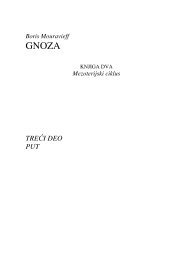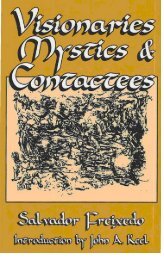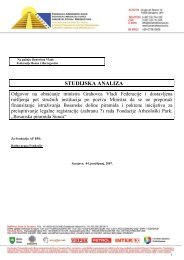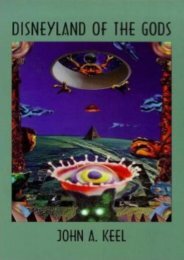The Complete Guide To Mysterious Beings - Galaksija
The Complete Guide To Mysterious Beings - Galaksija
The Complete Guide To Mysterious Beings - Galaksija
You also want an ePaper? Increase the reach of your titles
YUMPU automatically turns print PDFs into web optimized ePapers that Google loves.
try to assemble and present the available facts on these bizarre situations. As you go along, you will<br />
begin to note that there are striking correlations and similarities in many of these stories, no matter<br />
where or when they occurred. <strong>The</strong> smaller details become the most significant. Identical happenings<br />
have been reported in France, Brazil, and Ohio. Yet few, if any, of these stories have been widely<br />
circulated beyond the area of origin. If all these people are liars, then we had better launch a<br />
psychiatric program to determine how so many far-flung liars are able to come up with the same<br />
significant, correlating details in their lies.<br />
On the other hand, there exists a large and vocal group of men who are unreliable and often<br />
irresponsible. Over the past several years our work has brought us into almost constant contact with<br />
this group. <strong>The</strong>y call themselves ”scientists” and they usually put a Ph.D. after their names. Science<br />
has become a sacred cow in this generation but that term is a misnomer. <strong>The</strong> gender is wrong.<br />
Science, by and large, is a lot of bull.<br />
Hardly a month passes that yet another scientist is not caught in the act of faking his statistical<br />
material or cheating in his experiments. In recent years such scientific swindles as ”poly water” and<br />
”cold fusion” have stirred up headlines in the daily newspapers and bogus claims of new scientific<br />
discoveries have become commonplace. <strong>The</strong> once-rigid standards of academia have been replaced<br />
by overinflated egos, continual personality conflicts, cheats, frauds and fakers of every description,<br />
and a complete absence of ethics in the mad pursuit for fat government grants. Science has become<br />
a major disgrace and scientists now rank close to politicians in terms of credibility.<br />
In all fairness, we must admit that there are two kinds of scientists. Type A works for a large<br />
corporation or an important government agency. He is a proven producer. He has helped develop<br />
new soaps and toothpastes and atomic engines. He is rarely quoted in the press. In his spare time he<br />
writes scholarly papers that make a contribution to his chosen field. While he can have a large ego<br />
and other human failings, he does not seek publicity and his rare public statements are carefully<br />
worded and often make good sense.<br />
Type B is not a producer. He is usually a teacher at some university or small college. He is caught<br />
up in the vicious ”publish or perish” atmosphere of our educational system and so he also grinds out<br />
reams of books and papers, generally based on a systematic plagianism of the works of Type A. He<br />
seeks publicity and is frequently seen placing his foot in his mouth. It is a common practice for<br />
newspapermen to call upon the nearest available ”authority” when an unusual event occurs. If, for<br />
example, a meteor flashes across the local skies, the reporter will phone the professor of astronomy<br />
at the nearest school. This professor will either talk off the top of his head or he will scurry to his<br />
bookshelf and quote from the works of a Type A scientist.<br />
Much of the scientific rubbish you read in your daily newspapers comes from the mouths of Type<br />
B. Type A is usually too busy, too inaccessible, and too smart to pontificate for the press.<br />
For years Type B scientists have been telling us that the Abominable Snowman did not exist. None<br />
of these men had ever ventured closer than three thousand miles to the Himalayas. <strong>The</strong>ir conclusion<br />
was based upon the fact that no scientific literature existed on the subject. Similarly, a number of<br />
college professors, without bothering to talk to a single witness, identified West Virginia's<br />
”Mothman” as a kind of ordinary bird.<br />
Back in 1938 some fishermen in South Africa found a very odd specimen in their nets. It turned out<br />
to be a coelacanth fish which had been considered extinct for many thousands of years. <strong>The</strong>n the<br />
fun began. Recently Ivan T. Sanderson, a biologist and one of the world's leading authorities on<br />
animal oddities, commented on the coelacanth fracas:<br />
A certain Doctor of Piscology, i.e. Ichtyology, stated for the record, and to none less than the<br />
Associated Press, on the hearing of the initial announcement of such a fishy thing having<br />
been obtained by a Dr. Latimer of the Port Elizabeth Museum in South Africa, that it was<br />
impossible, because ”we all know” that all coelacanths have been totally extinct for some<br />
70-million years. That was in August, 1938. In August 1948, the same great expert stated,<br />
and to AP again, plainly, clearly and categorically that: ”This is probably the greatest<br />
zoological discovery of all time, but we [who are these wes?] have always expected it










